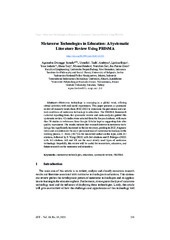Metaverse Technologies in Education: A Systematic Literature Review Using PRISMA
Аутори
Dwinggo Samala, AgariadneUsmeldi, Taali Ambiyar
Bojić, Ljubiša

Indarta, Yose
Tsoy, Dana
Denden, Mouna
Tas, Nurullah
Parma Dewi, Ika
Чланак у часопису (Објављена верзија)
Метаподаци
Приказ свих података о документуАпстракт
Metaverse technology is emerging as a global trend, offering virtual activities with real-world experiences. This paper presents a systematic review of research trends from 2012–2022 to determine the prevalence and current conditions of metaverse technology in education. The PRISMA framework (selected reporting items for systematic review and meta-analysis) guided this systematic review. 42 studies were selected from the Scopus database, with more than 70 studies or references from Google Scholar kept as supporting data after quality assessment. The results indicate that research interest in metaverse technology has significantly increased in the last ten years, peaking in 2022. Augmentation and simulation are the most prominent uses of metaverse technology in the learning process. C. Moro (2017) is the most cited author on this topic, with 313 citations, followed by P. Wang (2022) with 264 citations and P. Pelargos (2022) with 163 citations. AR and VR are the most widely used types of... metaverse technology. Hopefully, this review will be useful for researchers, educators, and future research on the metaverse and education.
Кључне речи:
metaverse technologies / education / systematic review / PRISMAИзвор:
International Journal of Emerging Technologies in Learning (iJET), 2023, 18, 5Издавач:
- International Association of Online Engineering
Финансирање / пројекти:
- Министарство науке, технолошког развоја и иновација Републике Србије, институционално финансирање - 200025 (Универзитет у Београду, Институт за филозофију и друштвену теорију) (RS-MESTD-inst-2020-200025)
Колекције
Институција/група
IFDTTY - JOUR AU - Dwinggo Samala, Agariadne AU - Usmeldi, Taali Ambiyar AU - Bojić, Ljubiša AU - Indarta, Yose AU - Tsoy, Dana AU - Denden, Mouna AU - Tas, Nurullah AU - Parma Dewi, Ika PY - 2023 UR - http://rifdt.instifdt.bg.ac.rs/123456789/2851 AB - Metaverse technology is emerging as a global trend, offering virtual activities with real-world experiences. This paper presents a systematic review of research trends from 2012–2022 to determine the prevalence and current conditions of metaverse technology in education. The PRISMA framework (selected reporting items for systematic review and meta-analysis) guided this systematic review. 42 studies were selected from the Scopus database, with more than 70 studies or references from Google Scholar kept as supporting data after quality assessment. The results indicate that research interest in metaverse technology has significantly increased in the last ten years, peaking in 2022. Augmentation and simulation are the most prominent uses of metaverse technology in the learning process. C. Moro (2017) is the most cited author on this topic, with 313 citations, followed by P. Wang (2022) with 264 citations and P. Pelargos (2022) with 163 citations. AR and VR are the most widely used types of metaverse technology. Hopefully, this review will be useful for researchers, educators, and future research on the metaverse and education. PB - International Association of Online Engineering T2 - International Journal of Emerging Technologies in Learning (iJET) T1 - Metaverse Technologies in Education: A Systematic Literature Review Using PRISMA IS - 5 VL - 18 DO - https://doi.org/10.3991/ijet.v18i05.35501 ER -
@article{
author = "Dwinggo Samala, Agariadne and Usmeldi, Taali Ambiyar and Bojić, Ljubiša and Indarta, Yose and Tsoy, Dana and Denden, Mouna and Tas, Nurullah and Parma Dewi, Ika",
year = "2023",
abstract = "Metaverse technology is emerging as a global trend, offering virtual activities with real-world experiences. This paper presents a systematic review of research trends from 2012–2022 to determine the prevalence and current conditions of metaverse technology in education. The PRISMA framework (selected reporting items for systematic review and meta-analysis) guided this systematic review. 42 studies were selected from the Scopus database, with more than 70 studies or references from Google Scholar kept as supporting data after quality assessment. The results indicate that research interest in metaverse technology has significantly increased in the last ten years, peaking in 2022. Augmentation and simulation are the most prominent uses of metaverse technology in the learning process. C. Moro (2017) is the most cited author on this topic, with 313 citations, followed by P. Wang (2022) with 264 citations and P. Pelargos (2022) with 163 citations. AR and VR are the most widely used types of metaverse technology. Hopefully, this review will be useful for researchers, educators, and future research on the metaverse and education.",
publisher = "International Association of Online Engineering",
journal = "International Journal of Emerging Technologies in Learning (iJET)",
title = "Metaverse Technologies in Education: A Systematic Literature Review Using PRISMA",
number = "5",
volume = "18",
doi = "https://doi.org/10.3991/ijet.v18i05.35501"
}
Dwinggo Samala, A., Usmeldi, T. A., Bojić, L., Indarta, Y., Tsoy, D., Denden, M., Tas, N.,& Parma Dewi, I.. (2023). Metaverse Technologies in Education: A Systematic Literature Review Using PRISMA. in International Journal of Emerging Technologies in Learning (iJET) International Association of Online Engineering., 18(5). https://doi.org/https://doi.org/10.3991/ijet.v18i05.35501
Dwinggo Samala A, Usmeldi TA, Bojić L, Indarta Y, Tsoy D, Denden M, Tas N, Parma Dewi I. Metaverse Technologies in Education: A Systematic Literature Review Using PRISMA. in International Journal of Emerging Technologies in Learning (iJET). 2023;18(5). doi:https://doi.org/10.3991/ijet.v18i05.35501 .
Dwinggo Samala, Agariadne, Usmeldi, Taali Ambiyar, Bojić, Ljubiša, Indarta, Yose, Tsoy, Dana, Denden, Mouna, Tas, Nurullah, Parma Dewi, Ika, "Metaverse Technologies in Education: A Systematic Literature Review Using PRISMA" in International Journal of Emerging Technologies in Learning (iJET), 18, no. 5 (2023), https://doi.org/https://doi.org/10.3991/ijet.v18i05.35501 . .


